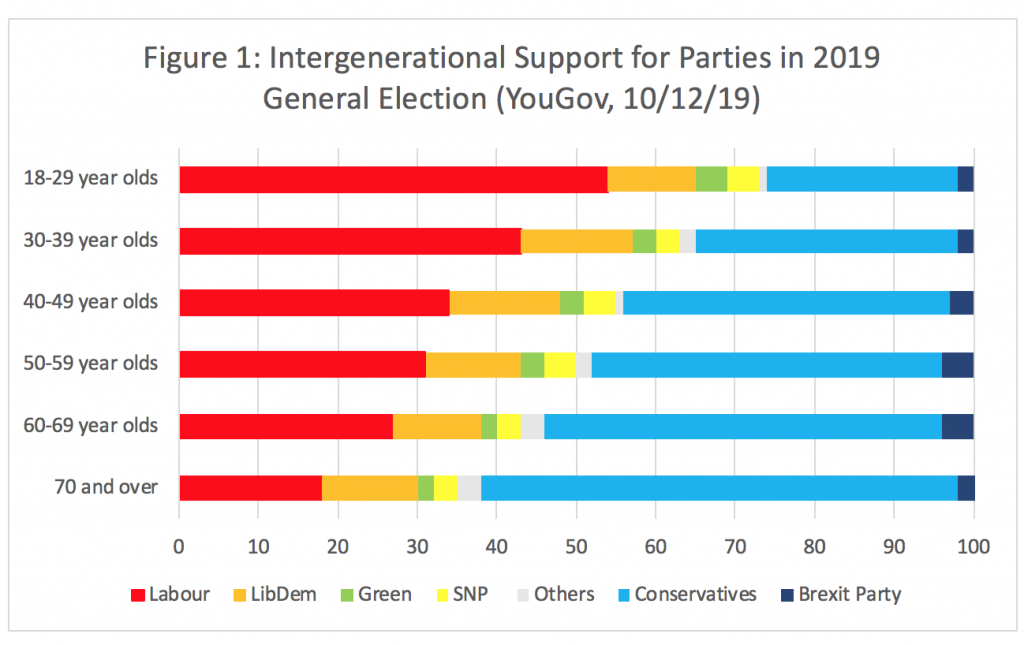
 The 2019 General Election proved to be huge disappointment for many young people, as younger cohorts were again outnumbered and outvoted in a UK election. James Sloam and Matt Henn explain how intergenerational cleavages deepened further in 2019, and how this reflects broader trends towards cosmopolitan values amongst younger citizens.
The 2019 General Election proved to be huge disappointment for many young people, as younger cohorts were again outnumbered and outvoted in a UK election. James Sloam and Matt Henn explain how intergenerational cleavages deepened further in 2019, and how this reflects broader trends towards cosmopolitan values amongst younger citizens.
On the surface, the 2019 General Election result was a devastating defeat for younger voters. 18- to 24-year-olds again came out in strong support of Jeremy Corbyn’s Labour Party, but were heavily defeated. Over the past decade, young people in the UK have emerged as a cohesive political force – in strong support of Remain and Labour – but have suffered a string of electoral defeats. Yet these recent events must be contextualised within broader intergenerational trends both within and beyond the arena of electoral politics.
The 2017 General Election was a landmark contest in many ways, when age replaced class as the best predictor of voting intention. In our book, Youthquake 2017: The Rise of Young Cosmopolitans in Britain, we highlighted the huge surge in youth political engagement. First of all, there was a spike in youth turnout (amongst 18- to 24-year-olds), rising to the highest level for a quarter of a century. Second, we identified a dramatic rise in support for the Labour Party amongst young voters, founded on a growth in social liberal or ‘cosmopolitan values’. A historic 60% of the youngest cohort of voters supported the Labour Party.
The left-wing orientation of younger voters was rooted in the negative impact of austerity (cuts in public spending) on younger generations. The cosmopolitan turn was underpinned by relaxed attitudes towards immigration, and support for the idea of cultural diversity, and manifested itself in mass youth engagement in the 2016 EU referendum (when around three-quarters of young voters supported Remain).
Clearly, these trends are not common to all young people – they were most common amongst students, young women, and young ethnic minority citizens – but the 2016 and 2017 votes demonstrated the remarkable rise of young cosmopolitans as a political force. And, they can be observed in many other established democracies: from Prime Minister Jacinda Ardern in New Zealand, to international climate campaigner Greta Thunberg, to the youth leadership of pro-democracy protests in Hong Kong. As Norris and Inglehart brilliantly showed in Cultural Backlash, socially liberal values are increasing within younger generations (despite the recent success of authoritarian-nationalist parties and candidates).
Since the 2017 General Election, we have witnessed a further surge – a youthquake in youth participation in response to the deepening climate crisis. Politically engaged young people across the world have joined a wave of political protest against climate change, which also has electoral consequences. In the 2019 European Parliament election, the Green Party performed well in many countries – scoring 30% amongst the under 30s in Germany (as much as the next three parties put together). We see this as further evidence of the rise of young cosmopolitans. In the UK, YouGov figures during the election campaign found ‘the environment’ to be the second most important issue for adults aged 18–29 (Brexit 55%, the environment 42%) but only the sixth most important issue for over 60s.
In 2017, the gap between Labour and the Conservative Party amongst 18- to 29-year-olds was the largest on record – 60% to 27%, respectively. At the time, we believed that the scale of these intergenerational cleavages would not be equalled. Although Labour support amongst younger voters decreased significantly in 2018 and 2019, it strengthened somewhat during the course of the 2019 campaign – up from 38% in the YouGov’s 17–28 October 2019 poll, to 54% in YouGov’s final pre-election poll.
In 2019, the gap between Labour and Conservatives remained around 30 percentage points, as both lost around five percentage points (Figure 1). But youth support for progressive parties increased overall. The pro-Remain Liberal Democrats more than doubled their support and the Green Party also made significant gains amongst younger voters. On the other hand, support for the Labour Party has reached an all-time low amongst older voters – falling to under 20% amongst over 70s. So, if anything, the intergenerational divide has deepened.
It is clear that a good proportion of Labour’s youth support has been transferred along cosmopolitan cleavages to the Liberal Democrats and the Green Party. For young cosmopolitans who prioritised Brexit, Labour’s ambiguous position was trumped by the Liberal Democrat’s unequivocal support for Remain. For young cosmopolitans who prioritised the environment, voting for the Greens Party was the only real response to climate change. However, given the reality of the first-past-the-post electoral system and Labour’s commitment to a huge Green transition, the Green’s youth support was dramatically squeezed, from 15% in YouGov’s October poll to just 4% in the final poll.
As we explained in our book, the period effect of the youthquake rippled up the generations. And, we can see this when we compare the political allegiances of 18–29s with those of 30–39s. Both age groups now show majority support for Labour, Lib Dems, Greens and SNP (over 70% amongst 18–29s and over 60% amongst 30–39s), representing a politics that is progressive anti-austerity/left-ist, cosmopolitan, and at least ‘open-minded’ about retaining EU membership (Labour), if not entirely Remain-supporting LibDems, Greens and SNP.
Despite the obvious disappointment of many younger voters with the result of the 2019 General Election, they will continue to be engaged in politics by other means – from street demonstrations for Remain, to school strikes against climate change, to direct action through Extinction Rebellion. If the past decade has shown us anything, it is that youth politics is increasingly bubbling up through social movements and other digitally networked forms of citizen action.
________________
 James Sloam is Reader in Politics at Royal Holloway University.
James Sloam is Reader in Politics at Royal Holloway University.
 Matt Henn is Professor of Social Research at Nottingham Trent University.
Matt Henn is Professor of Social Research at Nottingham Trent University.









My nonagenarian father-in-law might be interested to know what happens to voting patterns above the age of 70. Could it even be that those with a sensible lifestyle to live another 20 years are more likely to have progressive views than those in their 70s?
In any article that mentions “youth” or “young” or “younger” voters, it would be most helpful if the author(s) would provide numbers of prospective voters in each of the age brackets.
As others have pointed out, it’s difficult to find information about the turnout by age group in the 2019 election. There’s every reason to believe that the youngest voting group once again trailed all other groups in turning out for the 2019 election, both in numbers and in percentages.
The “youthquake” was a catchy term that might ultimately have signified nothing. The youngest voting group has almost no overall impact on election results and politicians have no doubt learned long ago that ineffectual voting blocs may truly be disregarded with little or no peril.
Agreed I can’t seem to find percentage turnout anywhere. Odd as surely that impacts on the validity of the popular charts going round.
I’m with Carole. Youth voters should express at the ballot box. So they need to turn up & vote. It is not the most exciting thing for them, but it is the most important thing to effect policy change. Unless they are out numbered in totality, even one vote can make a difference. Of course in 2019 wishy-washy Corbynism and Corbyn himself didn’t help and Liberal Dems could have ruined society with drug liberalisation policies. But now it would be 4 to 5 years when the next General Election rolls by and things would be dramatically different for the youth.
The angry young person syndrome rises from time to time particularly in universities where socio-economic studies are prevalent. Left wing politics are rife amongst theorists, including lecturers in these establishments. Universities in the 1960s , especially the London School of economics was a hotbed of Marxist thinking..
Interesting blog but please tell us what percentage of young people voted and what percentage of older folk. Thanks
Young people below a certain age contribute very little to the political debate. They live their lives on social media and dwell in the superficial and self obsessive world. The voting age should be increased to 25
I am interested to know what the turnout was by age, this year and compared to the past. My own students seem more engaged than in the past, but it dies seem turnout is something that would increase the power of young people’s collective voice.
Brunel University seem to have some figures re. turnout by age group. I think those of us, myself included, expecting a ‘youthquake’ somewhat mistook twitter, social media etc for the real world. There seems to be a small minority of youngsters who care passionately about politics, but most have no interest or have been put off politics altogether it seems.
https://www.brunel.ac.uk/news-and-events/news/articles/Labour's-car-crash-result-by-age-group